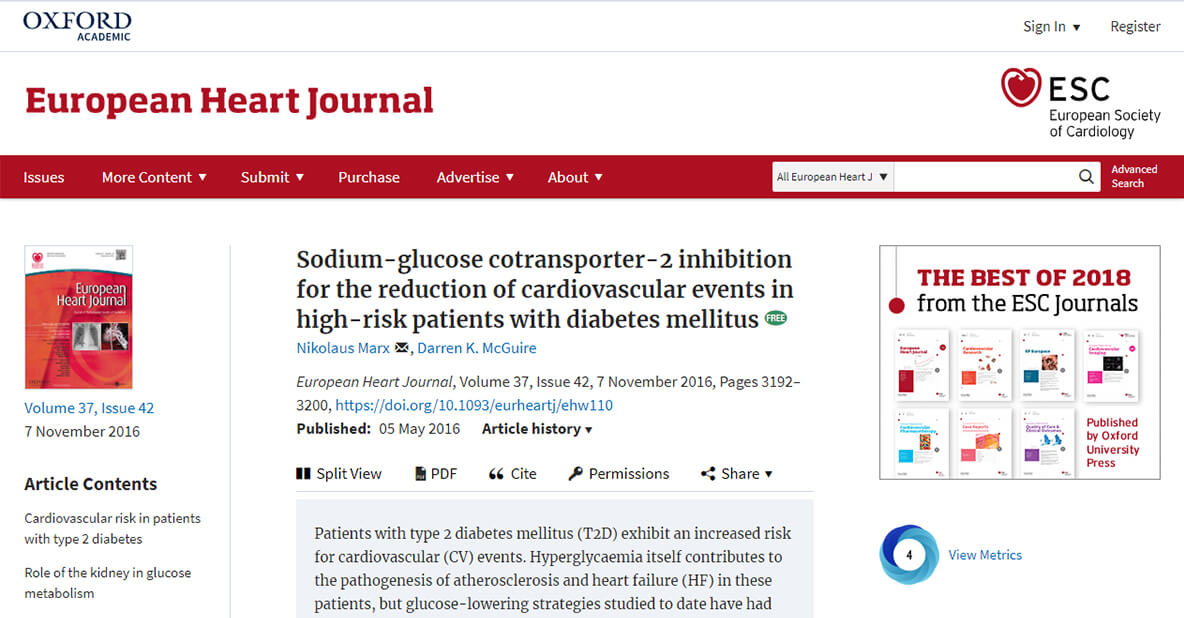Experts’ perspectives on the EMPA-REG OUTCOME (Kramer CK and Zinman B) Eur Heart J 37(42):3201-3202, 2016.
Document ID: ET-1273
07/12/2018
Author: Boehringer Ingelheim

Sodium–glucose co-transporter-2 (SGLT-2) inhibitors in patients with type 2 diabetes mellitus: the road ahead
Caroline K. Kramer, Bernard Zinman
European Heart Journal, Volume 37, Issue 42, 7 November 2016, Pages 3201–3202, https://doi.org/10.1093/eurheartj/ehw158
In light of the results of the EMPA-REG OUTCOME study which demonstrate for the first time a robust beneficial impact of an antidiabetic medication on CV outcomes, the use of SGLT-2 inhibitors preferentially for the patient population with T2DM and established CV disease might represent a new treatment paradigm to prevent CV disease in that setting.
Abstract: In this issue of the journal, Marx and McGuire have comprehensively reviewed the cardioprotective effect of the sodium–glucose co-transporter-2 (SGLT-2) inhibitors in patients with type 2 diabetes mellitus (T2DM).1 Given the results of the EMPA-REG OUTCOME trial, a better understanding of the mechanisms responsible for the effects of SGLT-2 inhibitors on the pathophysiological determinants of cardiovascular (CV) disease has become particularly relevant.2 As summarized in their excellent review, the EMPA-REG OUTCOME study demonstrated a 14% reduction in the primary CV outcome of major adverse cardiac events (MACE; non-fatal myocardial infarction, non-fatal stroke, and CV death) in individuals with T2DM and established CV disease who were randomized to the SGLT-2 inhibitor empaglifozin,2 primarily driven by a 38% reduction in CV death. Of note, SGLT-2 inhibitors exert potential beneficial metabolic effects beyond glucose control since these drugs promote weight loss, blood pressure reduction, natriuresis, changes in renal haemodynamics including reduction in intraglomerular hypertension, and neurohormonal homeostasis.1,3 These additional metabolic changes may very well be contributing to the cardioprotective effect of this class of antidiabetics.
From the endocrinology perspective, there has been great interest over the decades to identify antihyperglycaemic medications that would have added value beyond glycaemic control. For example, one important characteristic to consider when deciding on a particular antidiabetic medication is the potential to impact the inexorable progressive loss of pancreatic beta-cell function associated with T2DM.4 In this context, the ADOPT trial5 evaluating 4360 individuals recently diagnosed with T2DM randomized to 4-year treatment with rosiglitazone, metformin, or glyburide demonstrated a superior effect of rosiglitazone over metformin and glyburide as monotherapy. However, safety concerns and side effects (i.e. mainly fluid retention, weight gain, and increased congestive heart failure) have limited the use of glitazones and hence their applicability to clinical practice. Most recently, it has been demonstrated that a short-term course of intensive insulin therapy consisting of 2–4 weeks of a meal and basal insulin regimen could improve beta-cell dysfunction when administered earlier in the course of T2DM.6 While this treatment strategy is promising in that regard, larger randomized clinical trials are still needed to translate this potential benefit into clinical practice.
Given the increased risk of CV disease in T2DM, another very relevant characteristic of an antihyperglycaemic medication is the potential cardioprotective impact. In this context, several previous trials aiming to evaluate the impact of intensive glucose control on reducing CV events, such as ADVANCE,7 ACCORD,8 and VADT,9 failed to demonstrate a convincing positive impact of intensive glucose control on CV disease, suggesting that amelioration of hyperglycaemia per se does not impact atherosclerosis or its consequences. Recently, reflecting novel Food and Drug Administration (FDA) requirements, several trials aiming to assess CV safety of novel antidiabetic medications confirmed the lack of benefit of several antihyperglycaemic drugs regarding reduction of CV events. Specifically, these trials demonstrated a neutral effect of the dipeptidyl-peptidase-4 (DPP-4) inhibitors sitagliptin (TECOS),10 saxagliptin (SAVOR-TIMI),11 and alogliptin (EXAMINE)12 on CV outcomes, while the ELIXA13 trial demonstrated a non-inferiority of the glucagon-like-peptide 1 (GLP-1) receptor agonist lixisenatide. Although disappointing, improving glucose control remains a fundamental strategy to reduce the very prevalent microvascular diabetic complications (retinopathy, nephropathy, and neuropathy).
In this context, as addressed by Marx and McGuire,1 SGLT-2 inhibitors represent a class of antidiabetic medication with a unique mechanism of action: through their mechanism of inhibiting glucose and sodium reabsorption in the proximal tubule and thereby inducing urinary glucose excretion and natriuresis, SGLT-2 inhibitors ameliorate hyperglycaemia coupled with reduction in blood pressure, and weight loss.1 Most importantly, as compared with other antihyperglycaemic drugs whose mechanism of action typically involves an increase in insulin secretion (i.e. sulphonylureas, GLP-1 agonists) or reduction in insulin resistance (i.e. metformin, TZDs) resulting in either suppression of hepatic glucose production or increased tissue glucose uptake, SGLT-2 inhibitors enhance glucose disposal, which might represent an important metabolic mechanism responsible for the observed positive impact in CV outcomes.
There are still questions to be answered regarding the mechanism of action of SGLT-2 inhibitors and, most importantly, whether this beneficial effect is a drug class effect as indicated in the review.1 However, in light of the results of the EMPA-REG OUTCOME study which demonstrate for the first time a robust beneficial impact of an antidiabetic medication on CV outcomes,2 the use of SGLT-2 inhibitors preferentially for the patient population with T2DM and established CV disease might represent a new treatment paradigm to prevent CV disease in that setting.
Read full Text at ESC
PC-VN-100395
Production date: Dec 2018
Production date: Dec 2018

